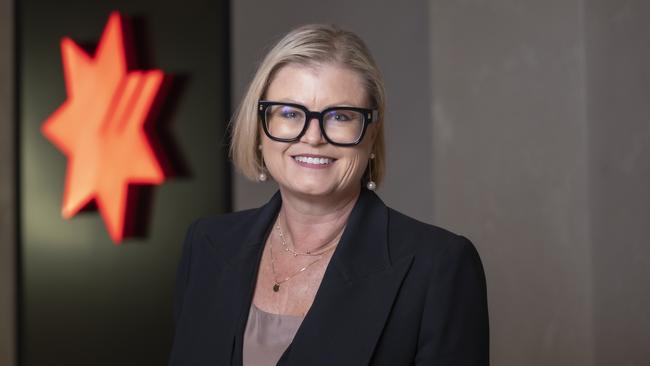NAB business banking chief Rachel Slade sees silver linings beyond clouded horizon
The big four bank’s head of business banking Rachel Slade says there’s more pain ahead in the near-term, with arrears to push higher in the coming months.

Businesses are holding on through the challenging operating environment but arrears will push higher in the coming months, with a broadbased deterioration coming in the next two quarters.
That’s the view of Rachel Slade, NAB’s head of business banking, who says the lender has a strong pipeline of growth for the year ahead, even as the near-term outlook worsens for businesses across the board, from SMEs to large corporates.
“My expectation is it’ll probably get a little bit worse before it gets better. Typically, the business part of the book sort of rolls through (some) months after the consumer part,” Ms Slade told The Australian.
“So (business stress) still probably has got a little way to go. But it’s orderly, there’s nothing rapidly accelerating there.”
Ms Slade was speaking to The Australian days after NAB chief executive Andrew Irvine handed down his maiden full-year result for the lender, showing an 8.1 per cent slide in cash profit to $7.1bn for the 12 months to September 30.
Underscoring the result was a jump in arrears as businesses and homeowners struggle with higher loan repayments. Arrears rose to 1.39 per cent, up from 1.13 per cent a year ago.
The economy was now at its toughest point in the cycle, Mr Irvine said, as he raised the prospect rates may come down slower than expected next year and beyond.
Even with loan arrears still to peak, business confidence is on the rise. NAB’s latest business survey, released on Tuesday, showed business confidence rose sharply in the month and is now back around average, and at its highest level since early 2023.
Business confidence rose seven points to five index points, with improvements across most industries, except for construction and retail. In trend terms, confidence remained weakest in retail and wholesale, the survey found.
Ms Slade said she was positive on the outlook for the year ahead, with business credit growth estimated to be about 5 per cent through 2025. (This is a slowdown from the 7.5 per cent credit growth seen in the past year.)
“It depends who you believe, in terms of soft landing or no landing for the economy, but I’m still pretty optimistic about the outlook. And if I look at our pipelines, which are really strong, in terms of deals and flow, it tells me we’re going to have a good year,” she said.
While NAB’s business lending jumped 8 per cent in the 12 months to the end of September, margins remain under pressure.
Ms Slade said the bank was focused on growing the balance sheet while managing margins tightly.
“It’s very competitive out there. There are a lot more dimensions to compete on than price. However, there’s some very aggressive pricing out there, and, for us, it’s about holding our position and playing our own game and competing where we do best, which is on service and relationships.
“If I look at our (growth) pipelines, which are really strong … it tells me we’re going to have a good year.”
NAB’s so-called “watch loans” climbed to 1.21 per cent of gross loans and acceptances, largely driven by business and private bank lending, and represented the highest level since mid-2022.
Watch loans at NAB are typically flagged by bankers making referrals or manually downgrading a customer rating as part of a review.
At the full-year result, the bank also said it had company-specific exposures within its business loan book it was watching, some of which were classified as individually assessed provisions.
While Mr Irvine didn’t identify specific customers when going through the results, NAB was a financier to ASX-listed Beston Global Food, which was placed in administration in September.
Banking analysts, meanwhile, will be closely watching NAB’s loan arrears over coming months, given the acceleration and expectations for further deterioration.
NAB shares closed up 40c at $38.40.





To join the conversation, please log in. Don't have an account? Register
Join the conversation, you are commenting as Logout